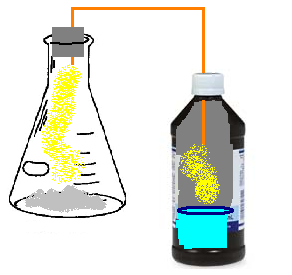guy
National Hazard
   
Posts: 982
Registered: 14-4-2004
Location: California, USA
Member Is Offline
Mood: Catalytic!
|
|
Best way to dissolve hydrogen chloride
I am going to make HCl gas by the reaction of molten NaHSO4 and NaCl. I plan to heat in a stoppered filter flask and lead the gas through a tube and
dissolve it in water. I don't know how dissolve well, since the diameter of the tube is about 1 cm.
|
|
|
12AX7
Post Harlot
    
Posts: 4803
Registered: 8-3-2005
Location: oscillating
Member Is Offline
Mood: informative
|
|
Best trick is to add a suckback bottle and use an upside-down funnel to bubble very soluble gasses, correct?
Tim
|
|
|
Magpie
lab constructor
    
Posts: 5939
Registered: 1-11-2003
Location: USA
Member Is Offline
Mood: Chemistry: the subtle science.
|
|
The inverted funnel method is commonly specified in organic lab manuals as a method for preventing the escape of byproduct HCl or HBr into the lab.
It is inherently anti-suckback as the funnel opening is placed just a hair above the water surface.
The old method was to lead glass tubing into a couple of sealed water bottles placed in series.
I don't think either of these methods was intended to optimize the absorption of gas. But since the gas examples above are so soluble they work
plenty well enough to prevent the escape of byproduct gas. At least in my experience they did.
To optimize absorption I would think a gas dispersion tube placed in cold water would be better. In this case I would use an anti-suckback bottle in
series as Tim has suggested.
[Edited on 25-3-2006 by Magpie]
The single most important condition for a successful synthesis is good mixing - Nicodem
|
|
|
BromicAcid
International Hazard
    
Posts: 3227
Registered: 13-7-2003
Location: Wisconsin
Member Is Offline
Mood: Rock n' Roll
|
|
A gas wash bottle would be great, they use a fritted glass circle to give very small bubbles that absorb rapidly. The inverted funnel trick is great
for anti-suckback because the whole funnel has to fill with water, it should be a large funnel though. Another possibility is to greatly wash some
sand so that it doesn't contiain any foreign matter, and run a tube under several inches of sand in the bottom of a vessel. Running the gas under the
sand serves to disperse the gas and force it to stay in the solution longer, but that likely isn't necessary for a gas as soluble as HCl.
Another method to prevent suckback is to put a sepretory funnel in the series so that the larger part of the bulp is toward the liquid that it's
bubbling through. If the liquid gets pulled through the tube and will end up in the funnel where you can see it, then you can close the stopcock
until the pressure builds back up before releasing it again and pushing all the water back into the absorption container.
|
|
|
gsd
National Hazard
   
Posts: 847
Registered: 18-8-2005
Member Is Offline
Mood: No Mood
|
|
In "Vogel's Textbook of Practical Organic Chemistry", 5th ed., there is an excellent discussion on gas absorption traps on pages 85, 86. Especially
the trap described on pg 86 is very good for continuous operation.
|
|
|
Nerro
National Hazard
   
Posts: 596
Registered: 29-9-2004
Location: Netherlands
Member Is Offline
Mood: Whatever...
|
|
Using a gaswashing flask (whats the word again? A bottle with a tubre going below waterlevel and another short one above it) filled with glasswool
worked ok too. The glasswool turns the big bubbles into small ones and it slows them down too.
|
|
|
I am a fish
undersea enforcer
   
Posts: 600
Registered: 16-1-2003
Location: Bath, United Kingdom
Member Is Offline
Mood: Ichthyoidal
|
|
Some more things to consider:
1. What temperature will the hydrogen chloride be generated at? For effective dissolution, it may need to cooled first. At the very least, I would
immerse the collection vessel in an ice bath.
2. How are you going to trap the residual HCl fumes? Assuming you want to run your apparatus at atmospheric pressure, you will need a vent at the
end of your collection run. If the collection process is inefficient, then you will end up with large volumes of a toxic and extremely corrosive gas
being spewed out into your lab. If I were you, I would (initially at least) add a second collection stage filled with sodium hydroxide solution, to
remove any final traces of the HCl.
1f `/0u (4|\\| |234d 7|-|15, `/0u |234||`/ |\\|33d 70 937 0u7 /\\/\\0|23.
|
|
|
guy
National Hazard
   
Posts: 982
Registered: 14-4-2004
Location: California, USA
Member Is Offline
Mood: Catalytic!
|
|
The collection bottle will be submerged in ice cold water. The HCl generated will probable be a higher temperature, because NaHSO4 has to be melted.
Is there a way to cover the filter flask's outlet thing, because I want to lead the gas through a smaller tube in the stopper? (I don't have an
erlenmeyer flask).
Will the attached design work?

|
|
|
Texium
|
Thread Moved
19-11-2023 at 11:07 |